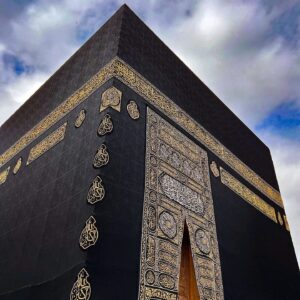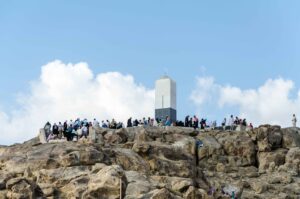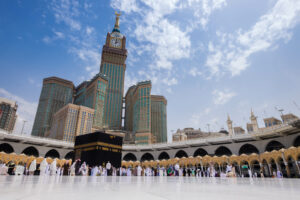The Kaaba, the cubic structure nestled within the Grand Mosque in Mecca, stands as one of Islam’s most sacred sites. Its significance transcends geographical boundaries, serving as the focal point for Muslims worldwide during their prayers. Yet, the story of its construction, steeped in religious lore and historical accounts, remains a subject of fascination and reverence.
Who built the Kaaba?
The current structure was built after the original building was damaged by fire during the siege of Mecca by Umayyads in 683 AD. This rebuilding occurred after Prophet Ibrahim (AS) returned to the valley of Mecca, years subsequent to leaving his wife Hajar and Ismail there in obedience to Allah’s command. The narrative begins with Prophet Ibrahim (AS) receiving a divine commandment to build a sanctuary dedicated to the worship of the One True God. Guided by heavenly instructions, Ibrahim (AS) and Ismail embarked on this monumental task, marking the inception of the Kaaba’s construction.
How was the Kaaba built?
The site chosen for this sacred edifice was the valley of Mecca, a barren desert region. As the foundation stone was laid, Prophet Ibrahim (AS) and Ismail worked tirelessly, laboring under the scorching sun, their hands guided by faith and determination. The dimensions of the Kaaba, precise and divine, took shape under their skilled hands, embodying a symbol of unity and devotion for generations to come.
The Black Stone, a meteorite believed to have descended from heaven, was bestowed upon Prophet Ibrahim (AS) during the construction of the Kaaba. Revered as a relic of heavenly origin, the Black Stone remains embedded in the southeastern corner of the Kaaba, serving as a cornerstone of Islamic rituals and veneration.
The construction of the Kaaba was not without its challenges. As the walls rose, Prophet Ibrahim (AS) and Ismail faced adversities, testing their resolve and unwavering faith. Yet, guided by their unwavering commitment to Allah’s (SWT) command, they persevered, surmounting every obstacle with resilience and steadfastness.
Why is the Kaaba important?
Upon its completion, the Kaaba stood as a testament to Prophet Ibrahim (AS) and Ismail’s unwavering faith and devotion. Its austere facade, adorned with simplicity, echoed the purity of their intentions and the unity of purpose in worshiping Allah the Almighty.
Over the centuries, the Kaaba underwent several renovations and expansions, each reflecting the evolving dynamics of Islamic civilization and the influx of pilgrims from diverse corners of the globe. Despite these alterations, the essence of the Kaaba remained unchanged—a sanctuary of spiritual solace and divine proximity for believers.
The significance of the Kaaba extends beyond its physical manifestation; it embodies the spiritual axis around which Muslims orient their lives. Five times a day, millions of Muslims worldwide turn towards the Kaaba during their prayers, symbolizing their unity in faith and devotion.
The annual pilgrimage to Mecca, known as the Hajj, represents the culmination of this spiritual journey. Muslim pilgrims from every corner of the globe converge upon the Kaaba, clad in simple white garments, transcending social, cultural, and geographical barriers in their quest for spiritual fulfillment.
The rituals of the Hajj, intricately woven around the Kaaba, encapsulate the essence of submission and surrender to the Divine Will. Circumambulating the Kaaba, pilgrims reaffirm their allegiance to Allah (SWT), while the symbolic act of stoning the devil signifies the triumph of righteousness over evil. A fundamental ritual in both the Hajj and Umrah pilgrimages is the Tawaf, wherein pilgrims circumambulate the Kaaba seven times counterclockwise. This act, known as Tawaf, is deemed obligatory for the completion of these sacred journeys. The pathway encircling the Kaaba, where pilgrims walk during Tawaf, is referred to as the Mataaf.
What is inside the Kaaba?
The Kaaba stands as a cuboid-shaped structure constructed primarily from stones, embodying an architectural marvel steeped in religious significance. Rising to an approximate height of 15 meters, its sides measure 12 meters in length and 10.5 meters in width.
Inside the Kaaba, the floor boasts a composition of marble and limestone, providing a sturdy foundation for the devout worshippers who visit. The interior walls are adorned with tiled, white marble extending halfway to the roof, complemented by darker trimmings along the floor. Elevated approximately 2 meters above the ground area where the ritual of Tawaf is performed, the interior exudes an aura of sanctity and reverence.
Adjacent to the entrance of the Kaaba, a wall features six tablets intricately inlaid with inscriptions, while additional tablets adorn the other walls, each bearing historical or religious significance. Atop the walls, a black cloth embroidered with gold Quranic verses gracefully drapes, adding to the aura of sacredness.
Caretakers meticulously anoint the marble cladding with scented oil, mirroring the ritual performed on the revered Black Stone situated outside. Within the confines of the Kaaba, three pillars stand, with a small altar or table positioned between one and the other two. Suspended from the ceiling are lamp-like objects, possibly lanterns or crucible censers, illuminating the sacred space. The ceiling itself boasts a darker hue, echoing the tone of the lower trimmings, imbuing the interior with a sense of solemnity and tranquility.
The story of the Kaaba’s construction serves as a beacon of inspiration for believers, reminding them of the power of faith and the enduring legacy of prophetic tradition. It symbolizes the unity of humanity under the banner of monotheism, transcending the boundaries of race, nationality, and creed.
In conclusion, the construction of the Kaaba stands as a testament to human endeavor and divine guidance. Its story, steeped in legend and history, continues to captivate the hearts and minds of believers worldwide. As the spiritual nucleus of Islam, the Kaaba remains an enduring symbol of unity, piety, and devotion—a timeless monument to the enduring bond between Muslims and Allah (SWT).






